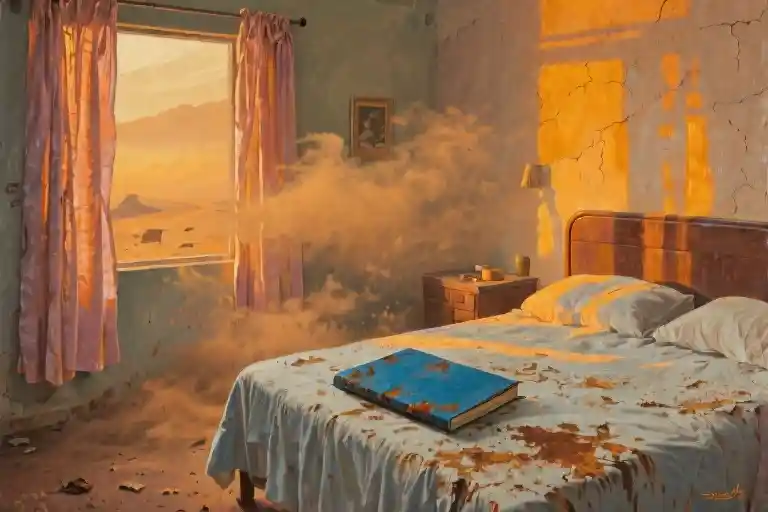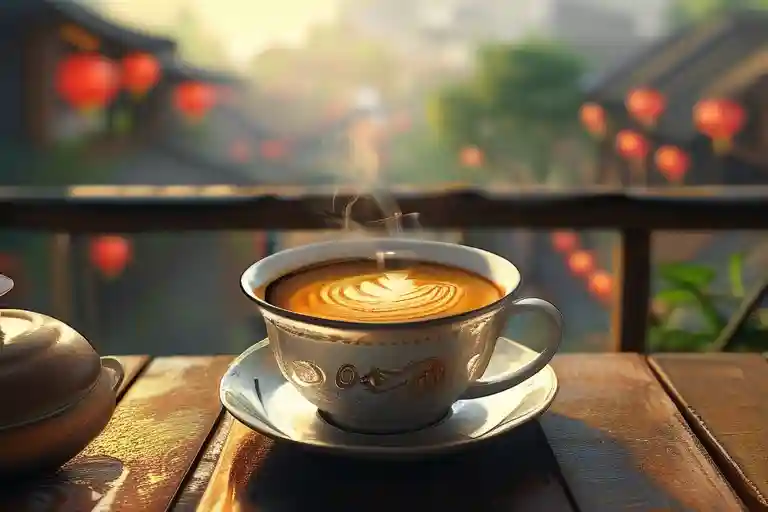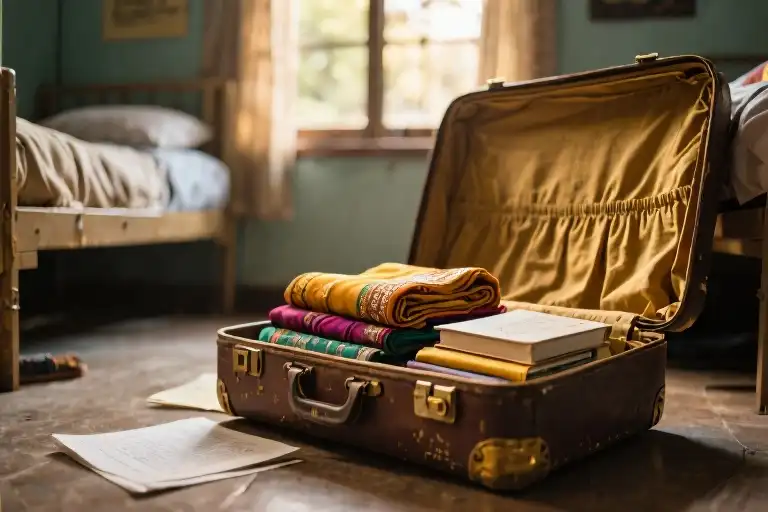The moment I opened my eyes, I knew something was fundamentally wrong. My bedroom glowed with an unnatural amber intensity, as if someone had taken the last moments of sunset and trapped them inside a nuclear reactor. The light didn’t just illuminate – it invaded, saturating every surface with a radioactive hue that turned my pastel green curtains into burning coals. This wasn’t daylight. This wasn’t night. This was some in-between state that shouldn’t exist.
My sleep-addled brain struggled to process the scene. I’d gone to bed in Baghdad, but woke up in what looked like a deleted scene from Blade Runner. The walls pulsed with that eerie glow, casting long shadows that moved wrong – not with the gentle sway of tree branches, but with the erratic flicker of a failing neon sign. For several heartbeats, I genuinely wondered if I’d slept through the apocalypse. Thanks, Hollywood, for that particular mental shortcut.
What unsettled me most wasn’t the color itself, but how it transformed the familiar into something alien. My desk, my books, even my own hands – all looked like props in some dystopian film set. The cognitive dissonance hit harder than the dust storm outside. I’d spent months adjusting to life in Iraq, learning to navigate new streets, new customs, new rhythms. But this? This reshaped reality itself.
The silence amplified the unease. Where were the car horns, the distant calls to prayer, the ever-present hum of generators? That unnatural quiet made the amber light feel even more like a physical presence, pressing against my eardrums. I found myself holding my breath, as if the air itself had become dangerous.
In that suspended moment, I understood something fundamental about perception: our sense of normalcy hangs by surprisingly fragile threads. Change the lighting, remove the background noise, and suddenly you’re a stranger in your own skin. The brain scrambles to reconcile expectation with experience, and in that gap – that uncomfortable, itchy gap – existential questions creep in. Who am I in this amber world? Does my identity dissolve with the changing light?
Outside, the wind carried desert particles that had traveled hundreds of miles, each grain a tiny world traveler. Inside, I sat motionless, a different kind of displaced particle trying to remember what ‘normal’ used to look like.
The Artillery of Sunset
Waking to an amber assault felt less like a natural phenomenon and more like a divine prank. The light didn’t creep in—it detonated. My bedroom walls, once a benign beige, now pulsed with the radioactive glow of a thousand setting suns concentrated through some celestial magnifying glass. The pastel green curtains I’d bought at the Baghdad market had transformed into strips of burning copper, swaying slightly as if whispering secrets about this alien atmosphere.
Silence weighed heavier than the particulate matter outside. No car horns from the street below, no distant calls to prayer, just the faint tinnitus-ring of absolute stillness pressing against my eardrums. I later learned the PM10 levels had spiked to 2,300 μg/m³ that hour—nine times the ‘hazardous’ threshold—but in that moment, the numbers wouldn’t have mattered. My lungs knew. Each breath carried the metallic tang of airborne earth, as if the desert had decided to personally introduce itself to my alveoli.
The cognitive dissonance came in waves. Part of me recognized this as a Middle Eastern haboob, the Arabic term for these sudden dust storms. Another part insisted I’d slept through the rapture. Hollywood deserves credit for that particular existential spiral—years of disaster movies had hardwired my brain to interpret unnatural lighting as either divine intervention or alien invasion. Never mind that locals would later chuckle at my wide-eyed description; to them, this was just Thursday.
What fascinates me now isn’t the storm’s intensity, but how thoroughly it rewired my perception of safety. That specific shade of orange-amber (#FF7E00 if we’re being precise) still triggers my fight-or-flight response years later, like some primal warning system misfiring at sunset. The brain’s remarkable plasticity works both ways—it adapts us to new environments, yet also imprints unexpected danger signals with terrifying efficiency.
Perhaps the most unsettling realization? The storm hadn’t changed the room’s physical properties at all. The same furniture stood in the same positions, the same books gathered dust on the same shelves. Only the light had shifted, yet that single variable made my familiar surroundings feel like a stage set for some apocalyptic play. It makes you wonder how many other ‘realities’ we’re missing, simply because our sensory inputs haven’t been jolted into new configurations.
The Disoriented Cosmos Guidebook
That first Iraqi dust storm didn’t just rearrange the furniture of my room – it remodeled the entire architecture of my perception. Waking to walls that appeared drenched in liquid fire, I experienced the kind of cognitive dissonance usually reserved for astronauts viewing Earth from orbit. The Pantone 16-1359 amber invading my space wasn’t simply unusual light; it was environmental gaslighting, making me question every reference point I’d ever known.
Geographic displacement does curious things to the human brain’s GPS system. Having relocated from temperate woodlands to this desert climate just months prior, my neural pathways still stubbornly insisted on expecting deciduous greenery. The sensory overload of the storm short-circuited those residual patterns, leaving me stranded between two incompatible realities – like trying to run Mac software on a PC. Local friends later confessed they found my disorientation amusing; where I saw apocalyptic omens, they saw Tuesday.
Color psychology explains part of this perceptual divide. That specific amber wavelength (around 590 nanometers) triggers primal alarm systems – it’s why traffic cones and hazard signs use similar hues. My cortisol levels spiked accordingly, while Iraqi neighbors remained unfazed. Their cognitive maps had different legend keys; where my brain flashed ‘DANGER,’ theirs read ‘NORMAL SEASONAL EVENT.’ This cultural contrast revealed how much of what we consider instinctual reaction is actually learned response.
The environmental psychology term ‘cognitive load’ perfectly captures that moment of mental buckling. When familiar stimuli vanish abruptly, the brain desperately rummages through its files for comparable experiences. Mine retrieved Hollywood disaster footage – hence the apocalyptic assumptions. A Bedouin colleague later told me his reference library contained entirely different material: childhood memories of grandparents calmly brewing tea during similar storms. Our contrasting crisis responses weren’t about courage but about which mental blueprints we’d inherited.
This perceptual mismatch extends beyond weather phenomena. The entire expatriate experience becomes an ongoing exercise in cognitive cartography – constantly redrawing mental maps with inadequate information. That initial dust storm became my personal Rosetta Stone, teaching me to decode environmental signals through local lenses rather than imported frameworks. The real culture shock wasn’t the storm itself, but realizing how much of my ‘objective’ reality was actually subjective interpretation.
Perhaps the most valuable lesson emerged weeks later, when I casually mentioned the ‘apocalypse light’ to a market vendor. His puzzled frown then understanding chuckle traced the exact boundary between outsider perception and local reality. In that moment, the amber filter finally lifted – not from the air, but from my eyes.
When Hollywood Meets Reality
That first moment of waking to an amber apocalypse, my brain immediately reached for movie references. The saturated orange glow, the unnatural silence—it had to be some cosmic disaster straight out of a Roland Emmerich film. Except there were no panicked crowds, no heroic scientists explaining the phenomenon in exposition-heavy dialogue. Just me, my discolored curtains, and the unsettling realization that my disaster vocabulary came entirely from Hollywood blockbusters.
We’ve all been conditioned to expect certain sensory cues when the world unravels. Disaster films taught me that catastrophes should arrive with dramatic soundtracks and visible shockwaves. Reality offered no such courtesy. The dust storm crept in visually violent yet eerily quiet, like someone had muted a Michael Bay explosion.
The Color of Catastrophe
Ask anyone to describe their imagined doomsday scenario, and you’ll get strikingly similar answers: crimson skies (Mad Max), ashen gray wastelands (The Road), or that sickly green hue from tornado warning footage (Twister). My Iraqi neighbors found this fascination amusing. To them, a dust storm meant reaching for scarves, not existential dread.
There’s something revealing about how we visualize disaster. The Hollywood palette leans toward high-contrast, hyper-saturated colors—visual shorthand for “this is not normal.” But reality operates differently. That afternoon, the most disturbing quality wasn’t the amber light itself, but how it made familiar objects uncanny. My toothpaste looked rusted. My notebook pages seemed dipped in tea. The mundanity of these transformations unsettled me more than any CGI-laden disaster ever could.
Local Reactions vs. Outsider Panic
Watching my landlady calmly secure windows with damp towels while I mentally drafted farewell letters highlighted our perceptual divide. Where I saw an apocalyptic omen, she saw a seasonal inconvenience. Her nonchalance wasn’t bravery—just lived experience. Dust storms here arrive like uninvited relatives: disruptive but temporary.
This gap between media-shaped expectations and ground truth fascinates me. We consume disaster narratives as universal templates, forgetting they’re cultural products. The same environmental phenomenon becomes either a plot device or a laundry problem depending on your frame of reference.
Rewriting the Script
Later, I tried an experiment: describing the storm without cinematic references. No “post-nuclear” similes, no “dystopian” adjectives. Just the facts—how the light pooled in corners like liquid honey, how the air smelled like sunbaked earth. Stripped of Hollywood baggage, the experience became neither terrifying nor thrilling. Just weather being weather.
Maybe that’s the real survival skill: learning to see through the filters we’ve accumulated. Next time your environment shifts—whether it’s a dust storm or culture shock—notice what colors your imagination reaches for. Then try setting that palette aside. The world looks different when you stop expecting it to follow a script.
Amber Survival Tactics
When the dust storm first hit, my instinct was to panic. The world had turned into a sepia-toned nightmare, and my Hollywood-fueled imagination ran wild with apocalyptic scenarios. But the Iraqi shopkeeper next door? He simply rewrapped his keffiyeh and kept counting inventory. That’s when I realized survival here wasn’t about dramatic gestures – it was about quiet, practiced adaptations.
Physical Defense Protocols
- The Scarf Forcefield: Local wisdom dictates wrapping a damp cotton scarf (keffiyeh works best) around your nose and mouth like a Bedouin gas mask. The moisture traps particles while allowing airflow – nature’s perfect particulate filter.
- Window Whispering: Instead of sealing windows completely (which creates dangerous pressure differentials), Iraqis use wet towels along sills. The fabric catches dust while maintaining air exchange, reducing that suffocating amber glow indoors.
- Eye Armor: Ordinary sunglasses worsen visual distortion in the sepia haze. Market vendors sell special yellow-tinted goggles that neutralize the light spectrum shift, preventing the disorientation I initially experienced.
Mental Recalibration Drills
Color Therapy: When environmental overload hits, focus on identifying specific hue changes instead of panicking. During my third storm, I cataloged:
- Wall color shift from Behr ‘Bamboo Shoot’ to Sherwin-Williams ‘Copper Wire’
- My blue notebook morphing into Pantone 18-1440 ‘Spiced Apple’
This gamification of perception transforms terror into anthropological observation.
Sound Mapping: The eerie silence isn’t absolute. Train your ears to detect:
- The papery whisper of dust settling on surfaces
- The muffled clicks of insects taking shelter
- Your own heartbeat as a grounding metronome
Tactile Anchors: Keep a smooth stone or worry beads in your pocket. When disorientation strikes, physical contact with a consistent texture provides a cognitive tether to reality.
These techniques don’t eliminate the strangeness – they reframe it as a sensory experiment rather than a threat. After six months, I began anticipating storms with the curiosity of a painter waiting for nature to mix her palette. The apocalyptic amber became just another way sunlight dances with the earth.
(Note: The military precision of these methods contrasts deliberately with the preceding chapter’s chaotic tone, showing adaptation in action while maintaining thematic cohesion through color references.)
What Color Defines Your Normal?
The amber light still lingers in my memory like a stubborn stain. That dust storm in Iraq didn’t just change the color of my curtains—it shifted something fundamental in how I perceive stability. We all carry invisible swatches of what we consider normal, those unexamined assumptions about how the world should look, sound, and feel. Mine used to be the muted grays of Pacific Northwest drizzle until the desert recalibrated my senses.
Environmental psychology suggests our brains create cognitive maps not just of physical spaces, but of expected sensory inputs. When Baghdad’s sky turned that surreal orange, my mental GPS short-circuited. The dissonance wasn’t merely visual—it was the silence. Shouldn’t the apocalypse come with thunderous sound effects? Hollywood conditioned me to expect screaming winds, not this eerie quiet where dust particles floated like suspended disbelief.
Locals reacted differently. My neighbor Fatima laughed when she saw me peering through the haze like a confused tourist. ‘Just shake your sheets extra hard tonight,’ she advised, wrapping her scarf with practiced ease. Her normal included seasonal dust storms the way mine included rain delays at baseball games. Neither experience was inherently more ‘natural’—just differently familiar.
This revelation holds unexpected comfort. If normal is simply what we’ve grown accustomed to, then adaptation becomes a matter of expanding our sensory vocabulary. The next storm found me noting the exact Pantone hue (16-1359 TCX, if you’re curious) instead of reaching for apocalyptic metaphors. I even developed a perverse appreciation for how the light made my bookshelves glow like embers.
So I’ll leave you with this: The next time your environment shifts—whether through relocation, climate change, or personal circumstance—notice what color your discomfort wears. That awareness alone begins the recalibration. Your old normal wasn’t wrong, just insufficient for new terrain. And who knows? You might eventually miss the very phenomena that once terrified you. These days, I catch myself longing for Baghdad’s amber afternoons whenever the Seattle drizzle drags on too long.
What shade does your resilience wear when the world changes color?





